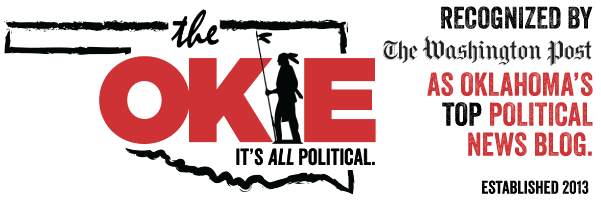Holt Outlines Bold Plan For $10K Teacher Pay Raise
For Immediate Release: January 21, 2016
Sen. Holt proposes $10,000 teacher pay raise, introduces package to implement without tax increase
Sen. David Holt is proposing a $10,000 teacher pay raise, and he has introduced a package of six pieces of legislation to implement the pay raise without a tax increase, using a multi-year, multi-faceted approach that can be considered this legislative session. Oklahoma teachers have not received a pay raise since 2008 and salaries now lag behind the national average by more than $10,000.
“I believe that Oklahoma’s future success depends on educated citizens, which depends on great teaching, which depends on competitive salaries for teachers,” Holt said. “Our salaries are not competitive, which means we will ultimately fail to meet our goals as a state. As the son of a retired teacher, a parent of a public school student, and a cheerleader for Oklahoma’s future, I appreciate the urgent need from various perspectives.”
Holt, R-Oklahoma City, said even though current budget shortfalls require a multi-year approach, he believes there is a “moral obligation” to address the issue in a definitive way this legislative session, and his plan is designed for immediate consideration.
“I believe I am proposing a practical and realistic solution, and to achieve that on this issue, I think a plan must have at least three characteristics – no tax increase, multi-year implementation, and a multi-faceted approach. By multi-faceted approach, I mean that there is no silver bullet. You can’t accomplish this with one idea or one bill,” Holt said. “I believe a teacher pay raise must rest on a three-legged stool of tax reform, efficiencies in school administration, and a statutory commitment of future revenue growth. The precise details of my proposals may or may not be the perfect approach, but I believe strongly in these principles and this framework.”
There are approximately 41,000 public school teachers in the state of Oklahoma, meaning that a $10,000 raise will cost the state approximately $400,000,000. Holt’s package is intended to identify those funds without a tax increase. The timing of full implementation is determined by multiple factors, but Holt’s plan is intended to reach the goal as soon as is possible using the methods he has proposed.
Holt commented on why he outlined a raise of at least $10,000.
“I believe that if we’re not talking about at least a $10,000 raise, we’re not doing what it will really take to be competitive. A $10,000 raise would move Oklahoma’s current average near today’s national average, but a realistic plan for accomplishing this will take years to implement, at which time the national average will be even higher. We have to start thinking ahead of the curve, not years behind it.”
The senator also explained why he would not propose an increase in the income tax rate.
“Increasing the income tax rate is not something I believe the people of Oklahoma want, which means it is a political non-starter, and I wanted to make a proposal that is realistic,” Holt said. “Further, I don’t think it is good public policy to increase the income tax rate, as a competitive rate is a key contributor to future economic growth. But most importantly, I believe you can implement a significant pay raise without a tax increase, as I have demonstrated with my proposal. If you can do it without a tax increase, then that’s what you should do.”
Holt’s plan is composed of the following six pieces of legislation, which cumulatively lead to a $10,000 raise and likely more, if fully implemented. His comments follow the summaries.
Senate Joint Resolution 57 – This puts a state question on the November ballot that would require the Legislature during the 2017 legislative session to identify $200 million in ongoing annual savings by reforming tax credits, rebates, exemptions and deductions. If the measure is passed by the voters but the Legislature fails to accomplish its task, two years of future tax credits will be canceled.
Senate Bill 1238 – This works in concert with SJR 57 to codify this legislative session a $5,000 pay raise contingent on successful implementation of the goals set forth in SJR 57. The $5,000 pay raise is effective for the 2018-2019 academic year.
“There is no question that our tax system can be reformed and that revenues of $200 million can be identified without an increase in tax rates. I think there is wide agreement on those points, but we clearly need a push. This legislation creates that framework, and it brings tax credit recipients to the table as motivated partners in reaching a fair outcome. Further, it ensures that the savings go directly to teacher pay raises. I truly believe there is not one person who might ultimately be affected by tax reforms that wouldn’t like to be a part of funding a teacher pay raise.”
Senate Bill 1256 – This codifies that all revenue growth after Fiscal Year 2017 will be captured exclusively for future teacher pay raises, up to $200 million.
Senate Bill 1278 – This works in concert with the legislation above to codify this session a $5,000 pay raise contingent on the capturing of future revenue growth envisioned in SB 1256. The pay raise based on this captured revenue would be capped at $5,000, but could partially begin as soon as new revenues come in.
“We know that the economy will improve sometime in the future, and we know that state tax revenues will rise as well. Rather than an oral commitment, this makes it lawfully required that future revenue growth goes first to teacher pay raises. The current shortfall actually presents an opportunity to do something we might have otherwise found impossible. Two years ago, if you had suggested that the state find $200 million in existing spending and redirect it to teacher pay raises, it wouldn’t have happened because no one wants to rob Peter to pay Paul. But this year, we have no choice but to take money from Peter because we don’t have it. So, the hard part will already be accomplished. When revenue growth returns, it will no longer be spoken for. Let’s turn today’s pain into a future opportunity to increase teacher pay.”
Senate Joint Resolution 58 – This puts a state question on the ballot in November that would create the School Modernization and Renew Teaching (SMART) Commission to redraw Oklahoma’s school districts so that there are no more than 200 school districts statewide. The resolution calls for the burden of merger to fall equally on urban and rural communities and it bars the closing of any school site. The plan would face an up-or-down vote in the Legislature in the 2020 legislative session.
Senate Joint Resolution 59 – This puts a state question on the ballot in November that works in concert with SJR 58 to shift all of the administrative savings exclusively to teacher pay raises beginning in 2021. If the two $5,000 raises envisioned in SB 1238 and SB 1278 have already come to pass, then SJR 59 will work to help Oklahoma keep up with what will surely be escalating national teacher pay averages by 2021. Or, if SB 1238 and SB 1278 have not succeeded, SJR 59 will work to fill the gap.
“We all know that the time for efficiency has arrived. We can be a low tax state or we can be an inefficient state, but we can’t be both. If we want to be a low tax state, and I want that for Oklahoma, then we have to spend money wisely. This resolution creates the framework to finally do what we know has to be done, but accomplishes it fairly and in a way that protects school sites. Most importantly, the exclusive beneficiaries are teachers. If we’re going to merge district administrations, I think it is imperative that the savings go exclusively to teacher pay raises.”
Senator Holt’s teacher pay raise package can be considered in the 2016 legislative session that begins February 1.
-END-

